Reverse-Engineering The Industry
Third-party developers weren't always quite so revered in the video game industry, but a pair of legal decisions helped them earn their place at the table.
“We were the first ever third-party developer of video game cartridges, and we knew that we were opening up a whole new business. And it wasn’t just a matter of being in the right place at the right time. We built the necessary technologies, fought the lawsuits, and battled through Atari’s attempts to close off the retail channels to our product.”
— David Crane, the co-founder of Activision, discussing with Gamasutra the challenges created for the company upon its 1979 launch by Atari. Activision was formed by a group of Atari developers who felt that the company didn’t give them enough credit for their work. Atari spent years in legal battles with Activision, but failed to get the company to shut down. This move was good for Activision, which is still with us, but led to a glut of game developers for the Atari 2600—many of whom didn’t know that the hell they were doing. The lack of quality control in the industry led to the video game crash of 1983.
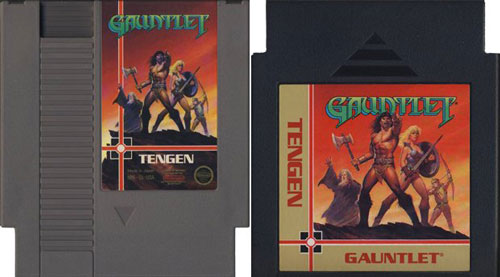
An officially licensed version of Tengen’s Gauntlet, side-by-side with an unlicensed version. (via True Viral News)
The story of Tengen, the Atari-owned Nintendo licensee that broke the rules every which way but down
Atari’s corporate history is pretty messy, and took a lot of left turns and dumb, dark roads.
The company and its spinoffs made a lot of mistakes over the years. Perhaps its biggest involved its poor handling of a controversial licensing policy put in place by Nintendo, a company that learned a whole lot of lessons from Atari’s failings with the 2600.
Nintendo of America, seeing the sheer amount of crap that was released on the Atari 2600—along with the poor quality control and the occasional pornographic games (NSFW)—took a much stricter approach to licensing than Atari ever did. The NES-maker, led by Howard Lincoln, limited the number of games a single company could produce, controlled the distribution of cartridges, and took a hefty share of the royalties for itself.
Tengen, a subsidiary of Atari spinoff company Atari Games, understandably chafed under these standards, as it limited the company’s flexibility in what it could release on the console. It had some early success, most notably with its game RBI Baseball, but by December 1988, the company had filed an antitrust lawsuit against Nintendo, claiming anticompetitive behavior.
(Complicating factors, in the midst of all this, was the fact that Tengen had released a version of Tetris in the U.S. without having the rights from the USSR to do so. Nintendo got those rights for itself, leading to a separate legal battle and further souring relations between the two companies.)
In many ways, Atari Games had the upper-hand in this case, because if Nintendo were to win, the losses would be staggering for the industry as a whole, Chicago Tribune writer Dennis Lynch noted at the time of the lawsuit.
“Whom should the average consumer root for? Clearly Atari Games,” Lynch wrote. “If it wins, certainly more cartridges and a wider variety of games will be available for users. If Nintendo wins, the negative consequences for the rest of the computer industry could be staggering.”
There was a problem, however. Atari Games made what could charitably be described as an unforced error and less charitably described as fraud. See, the secret to Nintendo’s control of the game market was the addition of a lockout chip called 10NES, which was intended to prevent unlicensed game-makers from accessing the console.
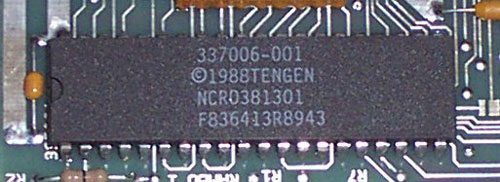
Tengen’s 10NES chip, which it produced by acquiring the blueprints from the U.S. Copyright Office.
It was mostly effective, though game-makers eventually found their way around the chip. Other unlicensed console makers, like Color Dreams and Camerica, got around the chip by using negative voltage spikes. But Atari Games used a much more questionable method: It reached out to the U.S. Copyright Office and asked for a copy of the 10NES code under false pretenses.
That gave Nintendo firmer standing in court for its case, which ultimately ended up in a U.S. appeals court in 1992.
“After obtaining the copy of the code from the Copyright Office, Atari made other intermediate copies of the program. Atari made photocopies of the Copyright Office copy, deprocessed chips, and hand-copied the 10NES object code from the deprocessed chip,” the case’s analysis stated. “Atari then entered this copied 10NES object code into a computer which aided in understanding the ideas in the program. The district court determined that this intermediate copying infringed Nintendo’s copyright.”
This was pretty much the opposite of “clean room” reverse engineering, and it bit Atari Games in the ass—removing what might have been a winning case and turning it into a rote example of copyright infringement.
Fortunately, another case decided around the same time answered many of the same issues at play in Atari Games Corp. v. Nintendo of America Inc.
“This was one of the first big cases where a licensee was challenging Nintendo, and it had a snowball effect. … Atari sued Nintendo for the same thing, the FTC investigated Nintendo, [and] it really caused Nintendo to ease their licensing restrictions.”
— Norman Caruso, the creator of The Gaming Historian, explaining to The Register the impact of Tengen’s antitrust battle with Nintendo over licensing rights. Even though Tengen lost big and was effectively barred from creating games for the NES, Nintendo’s practices were put on notice, and it ultimately changed its licensing standards down the line.
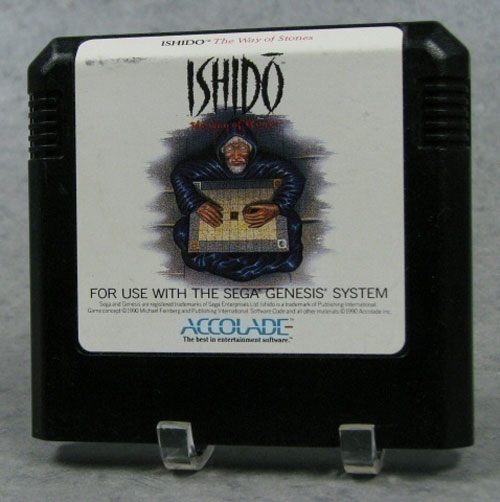
Ishido: the Way of Stones, an early unlicensed Accolade game for the Sega Genesis. (Museum of Play)
How Sega tried—and failed—to nail unlicensed game-makers by catching them in a lie
Around the time the Federal Appeals Circuit was trying to suss out the details of the Atari Games case, the Ninth Circuit was making some waves of its own on the issue of rights for third-party licensees.
And it was thanks to a very similar case that was based around the Sega Genesis, rather than the NES, but nearly all of the circumstances were the same.
Accolade, a video game developer with interests on numerous consoles and computing platforms in the early ’90s, had no interest in becoming an exclusive licensee on the Genesis, but that’s what Sega asked of developers at the time. Like Atari Games, Accolade tried to work around the console-maker’s systems. Unlike Atari Games, Accolade largely did so, minus most of the drama.
Accolade was largely able to figure out how to reverse engineer the console using just a few games and a version of the Genesis. The company, impressively, turned the outside code into a development kit of sorts.
What it found through reverse engineering was extremely bare-bones on the copy protection front. Sega had grown concerned about piracy from the Taiwanese market and had added its own security measures to prevent the use of pirated carts. The console relied on a patented system Sega called TMSS, or the trademark security system. This was installed on the Genesis II, which was then the most-recent version of the console.
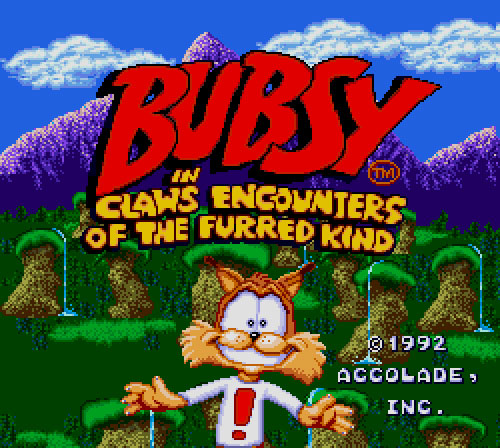
Bubsy in Claws Encounters of the Furred Kind, one of Accolade’s best-known games for the Genesis. This version is unlicensed.
TMSS was literally the least they could have done, though. Unlike Nintendo’s use of a physical chip in each cartridge, TMSS was a mere initialization code—roughly 20 to 25 bytes in length, including the letters S-E-G-A. When a cartridge included the code, it put a message on the screen informing the user that the cartridge they were playing was “Produced By Or Under License From Sega Enterprises Ltd.”
From a digital rights management standpoint, it was a security system designed to catch violators in a lie, which is kind of a weird way to secure something.
“TMSS was, truth be told, a terrible DRM implementation, even by the low standards of the field,” authors Aaron Perzanowski and Jason Schultz wrote in their recent book The End of Ownership.
This tiny smidgen of code, and its resulting message, became the bedrock of Sega Enterprises Ltd. v. Accolade Inc., which was decided by the Ninth Circuit a mere month after Atari Games Corp. v. Nintendo of America Inc.
There were a few questions created here: Was this code significant enough that its theft should be considered trademark infringement? Did the process that Accolade used to access this code violate Sega’s copyright? And did Accolade mislead its users by including a message claiming that Sega had licensed the game when it hadn’t? A lower court sided with Sega on these issues, but the Ninth Circuit differed significantly, specifically on the point of disassembly. A notable passage:
With respect to the video game programs contained in Accolade’s game cartridges, there is no evidence in the record that Accolade sought to avoid performing its own creative work. Indeed, most of the games that Accolade released for use with the Genesis console were originally developed for other hardware systems. Moreover, with respect to the interface procedures for the Genesis console, Accolade did not seek to avoid paying a customarily charged fee for use of those procedures, nor did it simply copy Sega’s code; rather, it wrote its own procedures based on what it had learned through disassembly. Taken together, these facts indicate that although Accolade’s ultimate purpose was the release of Genesis-compatible games for sale, its direct purpose in copying Sega’s code, and thus its direct use of the copyrighted material, was simply to study the functional requirements for Genesis compatibility so that it could modify existing games and make them usable with the Genesis console.
The ruling pushed the law into a significant new realm for computing, by finding that “where there is a legitimate reason for seeking such access, disassembly is a fair use of the copyrighted work, as a matter of law.” In other words, the ruling effectively made reverse engineering legal for the purpose of allowing interoperability between consoles.
And as for the trademark and false labeling issues highlighted by Sega? The court found that Sega, not Accolade, was responsible for the confusion created, as the code, in the end, only served a functional purpose.
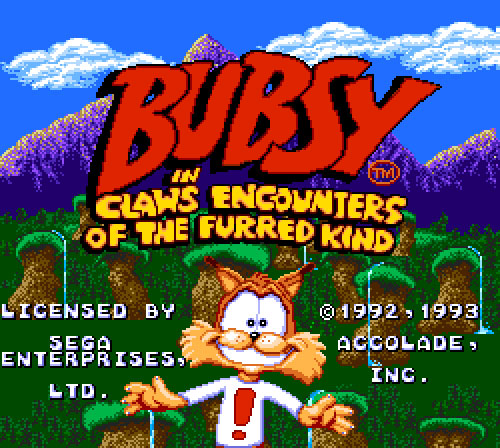
A version of Bubsy for the Genesis that has been licensed by Sega.
It was a big win for Accolade, leading to a proper licensing deal with Sega, and one that changed the shape of computing in the long run.
These days, third-party game developers hold much of the power in the video game sector—to the point where their existence on a platform can make or break a console—but these two cases are a pretty good reminder that it wasn’t always that way.
The Atari Games case, as corrupted as it was by the underhanded use of the U.S. Copyright Office to reverse-engineer its own lockout chip, likely would have favored Atari Games had the company not, you know, committed fraud.
Fortunately, it wasn’t the only case tackling the issue at the time. It would have been a pretty rough state of affairs if it were. As The End of Ownership notes, the Accolade case had a significant impact on legislation in general, creating a rules-of-the-road for digital rights management through two laws, the Audio Home Recording Act (AHRA) and the Digital Millennium Copyright Act (DMCA).
And while neither Accolade nor Atari Games are with us anymore, there was another Genesis developer who did exactly the same thing that Accolade did: A onetime PC games-maker that reverse-engineered Sega’s platform, then turned its success with the Genesis into a bargaining chip, which earned the developer the kind of sweetheart deal that it never would have if it were working with Nintendo.
That company is Electronic Arts—a firm that very much has not faded into the night.
:format(jpeg)/2017/03/tedium030917.gif)
/2017/03/tedium030917.gif)

/uploads/ernie_crop.jpg)